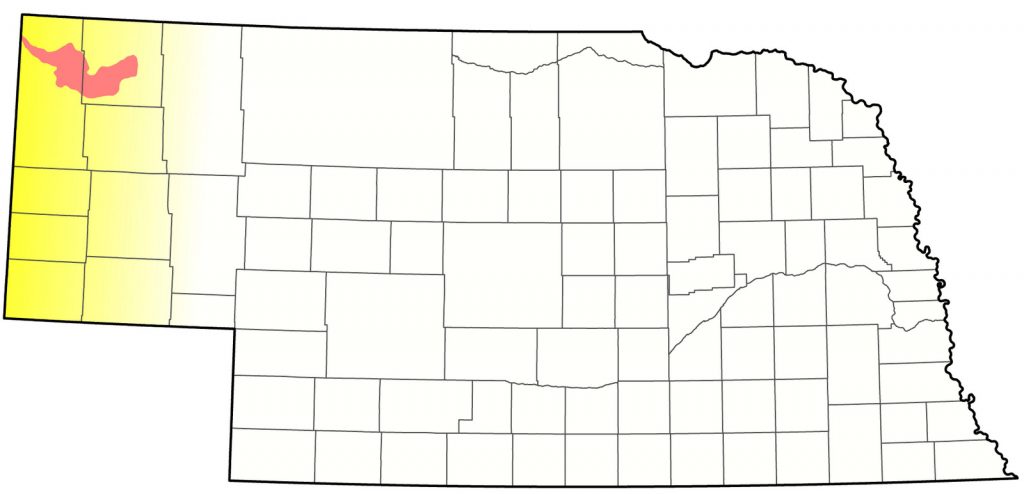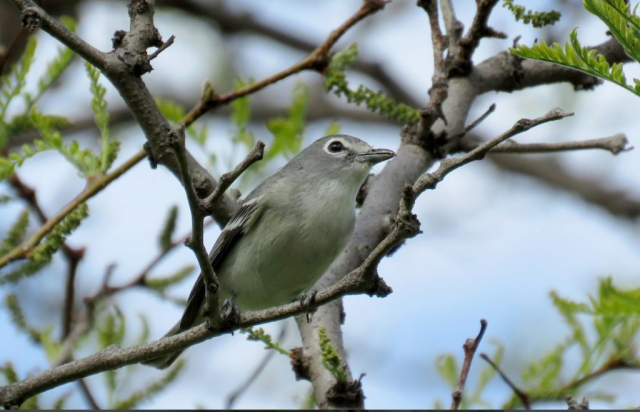Vireo plumbeus PLUMBEUS
Status: Increasing. Uncommon regular spring migrant west, accidental central. Uncommon regular breeder Pine Ridge. Uncommon regular fall migrant west, rare casual west central, accidental east.

Documentation: Specimen: UNSM ZM6773, 21 May 1900 Sioux Co.
Taxonomy: Four subspecies are recognized (AviList 2025), although differences between them are controversial (Goguen and Curson 2020). The only subspecies occurring north of Mexico is plumbeus.
Nebraska birds are presumed plumbeus.
A Plumbeous Vireo with another presumptive vireo near Wildcat Hills NC, Scotts Bluff Co 2 Jul 2015, where this species is not known to breed, was a notable observation. The identity of the second bird was not determined, but it had a “yellowish wash on the sides near the tail” and was thought by the observer to be a Cassin’s Vireo although its face pattern was not seen. Another confusing bird in Carter Canyon, Scotts Bluff Co 13 Jul 2023 had worn plumage, brown primary tips, and a yellowish flank wash was thought by Peter Pyle to be a second year Plumbeous Vireo or possibly a hybrid with Cassin’s Vireo.
Spring: May 9, 9, 9 <<<>>> summer
Earlier dates are 23 Apr 1993 Sioux Co (Grzybowski 1993), 3 May 2019 Dawes Co, 4 May 2020 Scotts Bluff Co, 6 May 2020 Sioux Co, and 7 May 2020 Banner Co.
Migrants are uncommon (Rosche 1982), but have been reported throughout the Panhandle, with one easterly exception: one was well-studied at Brule, Keith Co 28 May 1956 (Huntley 1957).
- High counts: 18 in Monroe Canyon, Sioux Co 18 May 2005, and 10 at Wildcat Hills SRA, Scotts Bluff Co 1 Jun 2019.
- In 2011 at least eight were reported in the southwest Panhandle 27-31 May; 15 were there 9-30 May 2024.
Summer: Low numbers breed on the Pine Ridge, which supports a disjunct population as in the Black Hills of South Dakota (Tallman et al 2002). In the 1980s, most breeding birds occurred from Sowbelly Canyon, Sioux Co westward (Rosche 1982), but in recent years the breeding range has expanded (or been discerned) eastward to Chadron SP, Dawes Co, where two were seen 3 Jun 2005 and two on 8 Jul 2007.
Reports between Sowbelly Canyon and Chadron SP are of a nest being built in East Hat Creek Canyon, Sioux Co 21 May 1996, an adult with a dependent fledgling in West Ash Canyon, Dawes Co 28 Jun 2006 (Mollhoff 2006), and two in West Ash Canyon 7 Jul 2007; a nest found in West Ash Canyon 5 Jun had a half-grown nestling 8 Jun (Mollhoff 2005).
Increasing reports in the Wildcat Hills in both Scotts Bluff and Banner Cos since 2017 suggest an establishing or previously overlooked population there; previously, there was a report in the Wildcat Hills 21 Jul 2012 and another there 2 Jul 2015 (see Comments). A territorial pair was found in the eastern part of Wildcat Hills SRA in Scotts Bluff Co 4 Jul 2017, and in 2018 one was in the same place 12 Jun. In 2018, along Hubbard’s Gap Road in Banner Co three were found 24 Jun and one on 30 Jul. Singles were at the Croft residence near the north edge of the Wildcat Hills SRA 30 Jul 2018 and 17 Jul 2019. In 2020 eight were in Carter Canyon 16 Jun, and up to four were elsewhere in the Wildcat Hills 5 Jun-24 Jul, and up to four singing males were present 14-20 Jun 2021. In 2023 breeding was documented apparently for the first time as one at Wildcat Hills SRA was carrying food 17 Jun. In all there were reports for the Wildcat Hills in 2023 of about 10 individuals, and one was at Buffalo Creek WMA, Banner Co 23 Jun. At least three were reported Jun-Jul in 2024 and nine Jun-Jul 2025 in Scotts Bluff and Banner Cos.
Reports in Jun away from the breeding range are likely spring stragglers: 6 Jun 2004 Wind Springs Ranch, Sioux Co, and 6-8 Jun 2008 at Crescent Lake NWR, Garden Co.
- Breeding Phenology:
Nest Building: 21 May
Eggs: 15-21 Jun - Nestlings: 17 Jun
Fledglings: 8-28 Jun
Fall: summer <<<>>> Sep 21, 22, 23
Later dates are 26 Sep 2022 Dundy Co, 26 Sep 2023 Oliver Reservoir, Kimball Co, 30 Sep 2015 banded Wildcat Hills NC, Scotts Bluff Co, and 12 Oct 1990 Keith Co (Rosche 1994).
Breeding birds begin to leave by late Jul; early migrants have been reported 26 Jul 2004 in southern Sioux Co, 29 Jul 2010 Bridgeport SRA, Morrill Co, and 30 Jul 2018 at Gering, Scotts Bluff Co.
Migrants are essentially restricted to the Panhandle. There are five records away from the Panhandle; the only record for the east was documented at Wood Duck WMA, Stanton Co 21 Sep 1997 (Brogie 1998). In the west central, singles were in Dundy Co 30 Aug and 7 Sep 2020 and 26 Sep 2022, and one was at Whitman, Grant Co 1 Sep 2002.
A very late report, 30 Oct 1977 Garden Co, may be of any of the three recently split species, but most likely Blue-headed, which tends to be a later migrant than Plumbeous or Cassin’s Vireos; Blue-headed is an Oct migrant as far west as the eastern Colorado plains (Andrews and Righter 1992). Andrews et al (2002) noted that Plumbeous Vireo is less numerous in fall migration at Barr Lake, Colorado, than is Cassin’s Vireo; some Sep reports of Plumbeous prior to 1997 were probably of Cassin’s Vireo.
A specimen, UNSM ZM6776, was taken 27 Aug 1921 in Sioux Co.
- High Counts: 7 in Sowbelly Canyon, Sioux Co 4 Sep 2016, 6 in East Ash Canyon, Dawes Co 5 Sep 2015, and 5 in Sowbelly Canyon 3 Sep 2018.
Images
Abbreviations
NC: Nature Center
NWR: National Wildlife Refuge
SP: State Park
SRA: State Recreation Area
UNSM: University of Nebraska State Museum
WMA: Wildlife Management Area (State)
Literature Cited
Andrews, R., and R. Righter. 1992. Colorado birds. Denver Museum of Natural History, Denver, Colorado, USA.
Andrews, R., R. Righter, M. Carter, T. Leukering, and A. Banks. 2002. Birds of Barr Lake and Surrounding Areas 1888 through 1999. Ornithological Monograph No. 1. Rocky Mountain Bird Observatory, Brighton, Colorado, USA.
AviList Core Team, 2025. AviList: The Global Avian Checklist, v2025. https://doi.org/10.2173/avilist.v2025.
Brogie, M.A. 1998. 1997 (Ninth) Report of the NOU Records Committee. NBR 66: 147-159.
Goguen, B., and D.R. Curson. 2020. Plumbeous Vireo (Vireo plumbeus), version 1.0. In Birds of the World (A. F. Poole, Editor). Cornell Lab of Ornithology, Ithaca, NY, USA. https://doi.org/10.2173/bow.plsvir.01.
Grzybowski, J.A. 1993. Southern Great Plains Region. American Birds 47: 272-273.
Huntley, C.W. 1957. Keith County. NBR 25: 24-25.
Mollhoff, W.J. 2005. The 2003-2004 Nebraska nest report. NBR 73: 15-19.
Mollhoff, W.J. 2006. The 2006 Nebraska nest report. NBR 74: 142-147.
Rosche, R.C. 1982. Birds of northwestern Nebraska and southwestern South Dakota, an annotated checklist. Cottonwood Press, Crawford, Nebraska, USA.
Rosche, R.C. 1994. Birds of the Lake McConaughy area and the North Platte River valley, Nebraska. Published by the author, Chadron, Nebraska, USA.
Tallman, D.A., Swanson, D.L., and J.S. Palmer. 2002. Birds of South Dakota. Midstates/Quality Quick Print, Aberdeen, South Dakota, USA.
Recommended Citation
Silcock, W.R., and J.G. Jorgensen. 2025. Plumbeous Vireo (Vireo plumbeus). In Birds of Nebraska — Online. www.BirdsofNebraska.org
Birds of Nebraska – Online
Updated 26 Aug 2025

